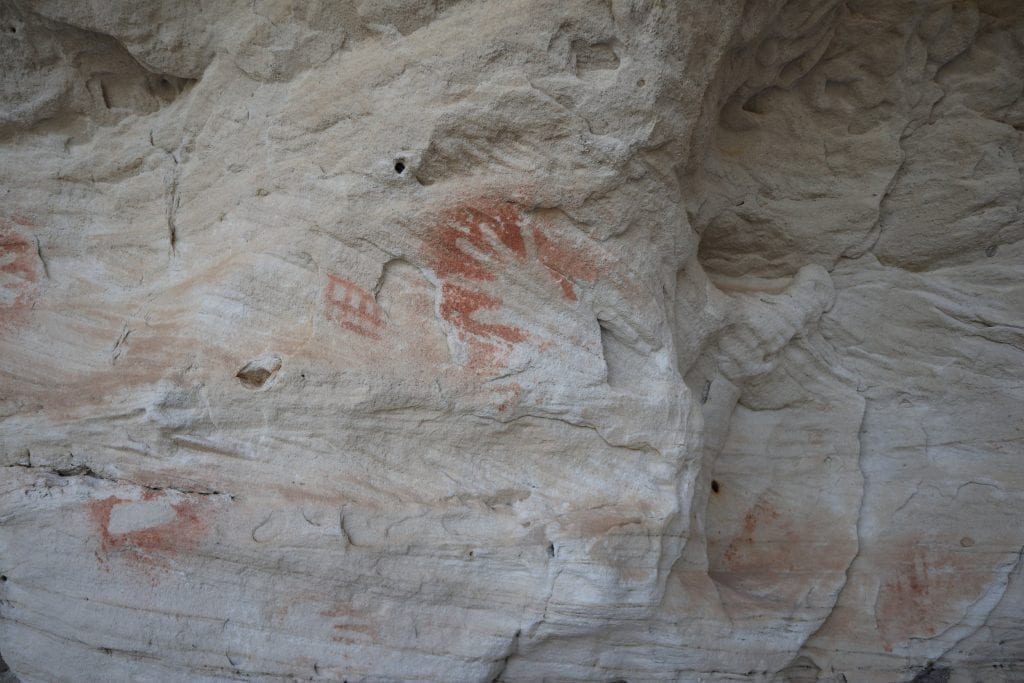Indigenous Conservation, State Forests
State forest cultural heritage sites
Ruined Castle Creek rock art site 1 showing yellow ochre boomerang stencil with superimposed hand stencils in red ochre. (NPAQ Library)
There are many significant cultural heritage sites in Queensland state forests. Here we look at our investigation into significant cultural heritage sites, primarily those of Aboriginal significance, in several Queensland state forests.
Here we summarise our study into nine state forests: Barakula, Boxvale, Bringalily, Bulli, Gurulmundi, Presho, Shotover, Whetstone and Yelarbon.
An initial assessment of the Aboriginal sites in these forests was conducted to determine which had the highest heritage values. This was done so that more detailed investigations could be carried out on the forests with the highest Aboriginal cultural heritage values.
Objectives
Our objectives were to establish whether known Aboriginal cultural heritage sites still retain their heritage values and identify whether the previously recorded sites survive, whether they can be located and if they still retain their heritage values. We also wanted to know whether these sites are being adequately protected and ascertain how additional sites might be identified through field surveys.
Methodology
A desktop evaluation of Aboriginal cultural heritage values in the nominated Queensland state forests was carried out from published site records. This was followed by a review of site cards for previously recorded sites in these state forests including an assessment of the likely accuracy of site locations, the potential for rediscovery and ease of access. We then modelled site occurrence and mapping of potential high sensitivity areas for later field inspection.
The theoretical work preceded engagement with relevant Traditional Owner groups enquiring about their priorities regarding heritage values in state forests. Locations of significance to them would only be investigated with their approval.
Once these engagements occurred, we conducted a site inspection program revisiting previously recorded sites, documenting conditions, and recording any evidence of deterioration since they were originally recorded.
We document these outcomes, and discovery of incidental sites of cultural heritage in our full report.
Our aim was to contribute to the case for the conversion of state forests to national park in those areas with highly significant Aboriginal site occurrence and very high archaeological sensitivity.
Results
While Indigenous cultural heritage site numbers are not the only indicator of site importance, the number of sites for each state forest is listed in table 1.
Desktop studies revealed three state forests with significantly important Aboriginal cultural heritage sites: Boxvale State Forest, Presho State Forest and Shotover State Forest.
 Table 1. Aboriginal cultural heritage site numbers in each of the nine state forests.
Table 1. Aboriginal cultural heritage site numbers in each of the nine state forests.
Boxvale State Forest
Boxvale State Forest has only a small suite of Aboriginal sites. The one rock art site that was relocated appeared not to be affected by cattle scuffage or rubbing of the rock art. Animals use the shelter and have affected the integrity of the occupation deposit in the shelter floor. There are few additional cultural heritage sites likely to be found in the Boxvale State Forest. With a current management regime for the regular cattle grazing and no short to medium term timber harvesting to threaten the cultural heritage values of Boxvale State Forest, further conservation action is not essential.
Presho State Forest
Presho State Forest has a very large suite of highly significant sites, predominantly rock art sites with stencilled art currently affected by cattle. The proximity of Presho State forest to other national parks with high cultural and natural heritage values suggests transition to national park may be a cost effective means to protect the cultural heritage values together with the natural heritage and biodiveristy benefits. There are currently grazing rights held on Presho State Forest so a negotiation of the surrendering of these rights would be required to facilitate ongoing management of Presho’s cultural heritage sites. As cattle rubbing against the rock art is the greatest threat to Presho State Forest sites, exclusion of cattle would help protect the heritage values of the sites.
Shotover State Forest
There are significant rock art sites in the Shotover State Forest including stencilled and painted art sites that are significant to the Gaangalu People. Gaangalu People are currently involved in site protection work in national parks and state forests on their traditional lands. Additional grant funding from State, Federal and independent funding agencies would help ensure that the sites in the Shotover State Forests are adequately protected. Cattle grazing also poses a threat to the integrity of important rock art sites in Shotover State Forest and exclusion of cattle from important sites is a priority.
The site location data on the Aboriginal Cultural Heritage Database is inaccurate. There is a desperate need to update the database and check on the location and condition of significant sites throughout Queensland.
There is a need for increased and regular involvement of Traditional Owners in the protection and management of sites in State Forests. This is taking place in Shotover State Forest as there are Gaangalu Rangers employed by QPWS who check on the sites as part of their normal duties. Additional funding should be made available for Traditional Owners to undertake appropriate site protection work, such as fencing, signs and site visits in Shotover State Forest.
Lessons for other forests
The Shotover model should be applied to other state forest land whether or not transition to national park is pursued (though this would be the most cost effective route to protection).
It was noted from discussions with QPWS officers working in Presho State Forest that there are limited resources for the protection of Aboriginal cultural heritage sites. Whatever the future of this site, it requires an increase in personnel and funding to fully record and regularly monitor the condition of sites. This could be leveraged through the Indigenous Sea and Land Rangers program.
The future of protecting cultural heritage in Queensland requires active resourcing and empowerment of Traditional Owner’s leadership of mapping and protection work.


